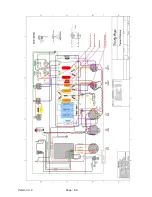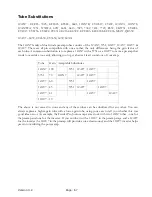
Version 3.2
Page: 52
REMEMBER: DO NOT OPERATE YOUR AMP WITHOUT A LOAD
Install a 2 AMP SLO BLO fuse.
Note: If you see or smell smoke when you turn on the amp, turn it off immediately and re-
check the connections.
1.
With no rectifier in place
, apply power and test the High voltage AC and ensure that
it is on the correct pins of the rectifier (pins 4 & 6) and in the correct voltage range
(greater than 350 Volts AC). Between pins 4 & 6 should read in the order or 760 V
AC. From pin 4 or 6 to ground, should be about half of that.
2.
Test the filament voltages and ensure they are on the correct pins for all tubes.
3.
5 VAC across pins 2 and 8 or V5, 5Y3 Rectifier.
4.
6.3 VAC across pins 2 and 7 on V4, V3 6V6 Power Tubes
5.
6.3 VAC across pins 4-5 pair and 9 on V2 12AX7 and V1 12AY7 Pre-Amp Tubes
6.
If all is OK, then shut off,
install the rectifier and apply power without the
preamp or power tubes installed.
Turn on the Stand-By switch on the Tweed. Check
the plate voltages on the tube sockets. The plate voltages will be higher than the
voltages listed on the schematic because there is no load provided by the tubes. It will
be in excess of 400 Volts DC.
7.
If everything is okay, power off the amp, install the 12AX7/AY7 and two power tubes
(6V6), connect a speaker and power on again.
8.
Measure the DC voltages from tube pin to chassis ground and compare to the layout,
schematic or Trinity Tweed Voltage Chart.
Tube
Plate Pin(s)
Cathode Pin(s)
Heater (pins)
V1 - 12AX7 V2 -12AY7
1,6
3,8
4+5, 9
V3, V4 - 6V6
3
8
2, 7
V5
–
5Y3
2, 8
9.
If the voltages seem close to the chart, then with volume setting at minimum and NO
instrument plugged in, power up again. Listen for sounds that may indicate a problem.
Loud transformer vibrations or humming or other crackling sounds. Observe if any of
the components besides the tubes are getting hot
–
check the power resistors. Carefully
check and make note of the voltages on all the tubes.
10.
If all seems in order, and the fuse has not blown, turn the volume up a bit. If
everything seems fine, plug in a cable, and touch one end. You should get a loud hum,
this is a good sign.
If you get this far, it’s time to plug in your guitar and take the amp
for a test run.
11.
Hopefully, there are no problems but if you think there are e.g. hum, squeal etc., then
move on to the troubleshooting section of this manual.
Summary of Contents for Trinity Tweed Amp
Page 2: ...Version 3 2 Page 2 ...
Page 16: ......
Page 20: ...Version 3 2 Page 20 Input Jack Theory from 18watt com ...
Page 25: ...Version 3 2 Page 25 ...
Page 49: ...Version 3 2 Page 49 ...
Page 65: ...Version 3 2 Page 65 HEYBOER OT for TWEED 6L6GT CONVERSION ...
Page 66: ...Version 3 2 Page 66 ...
Page 75: ...Version 3 2 Page 75 ...
Page 76: ...Version 3 2 Page 76 ...
Page 77: ...Version 3 2 Page 77 Trinity Amps Schematics and Layouts ...















































